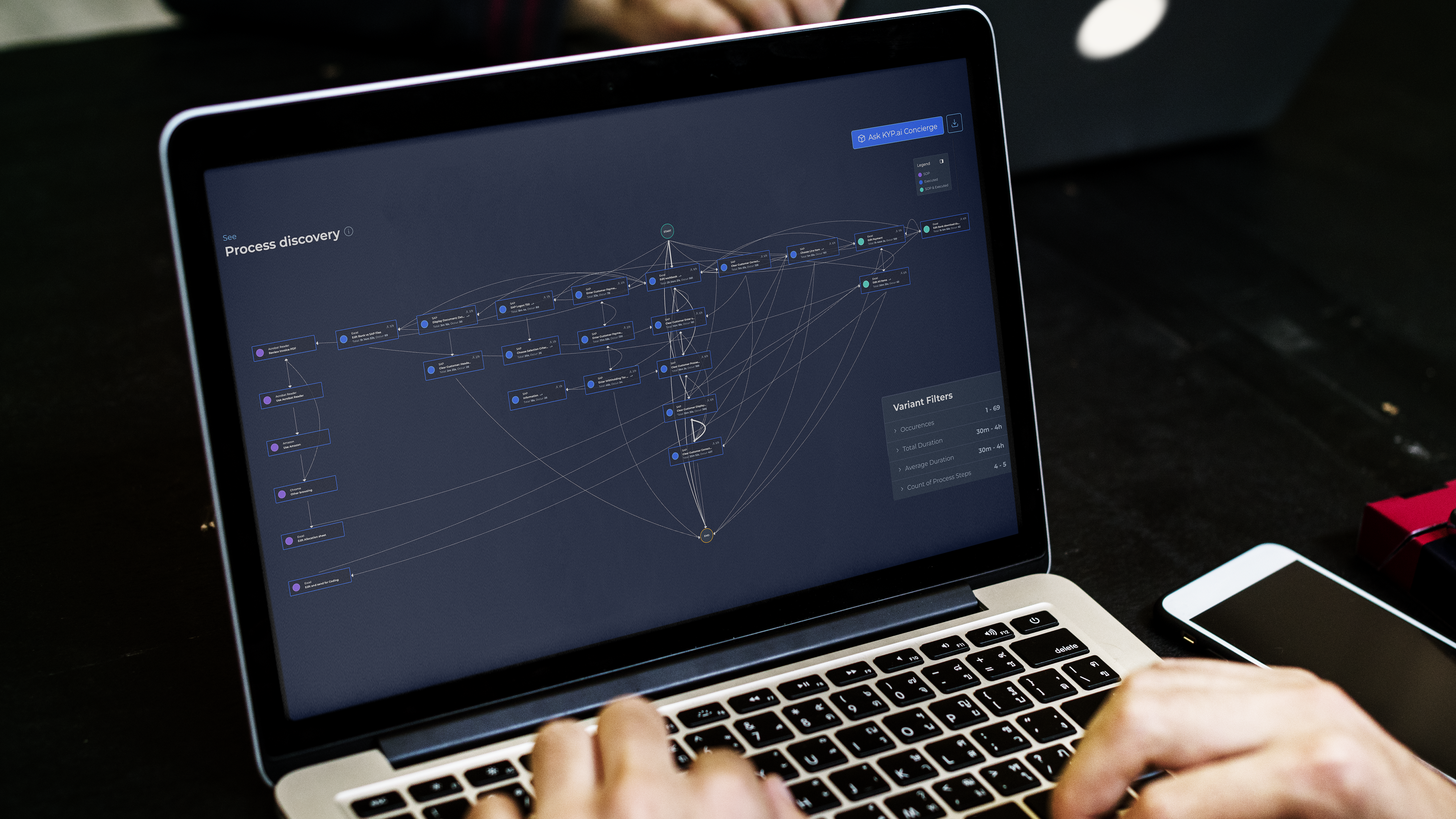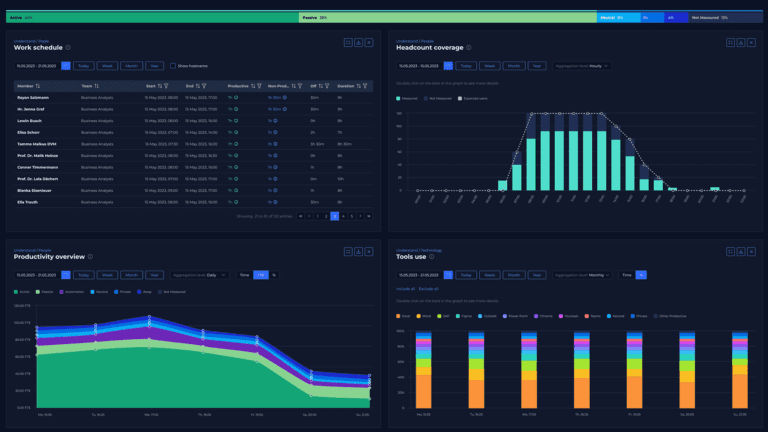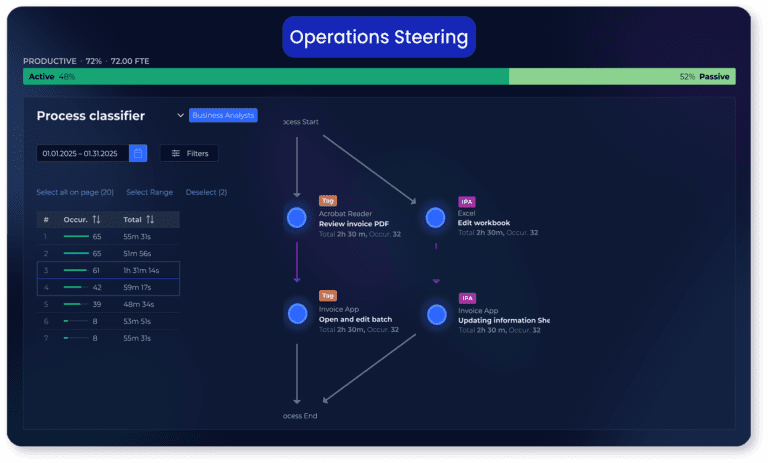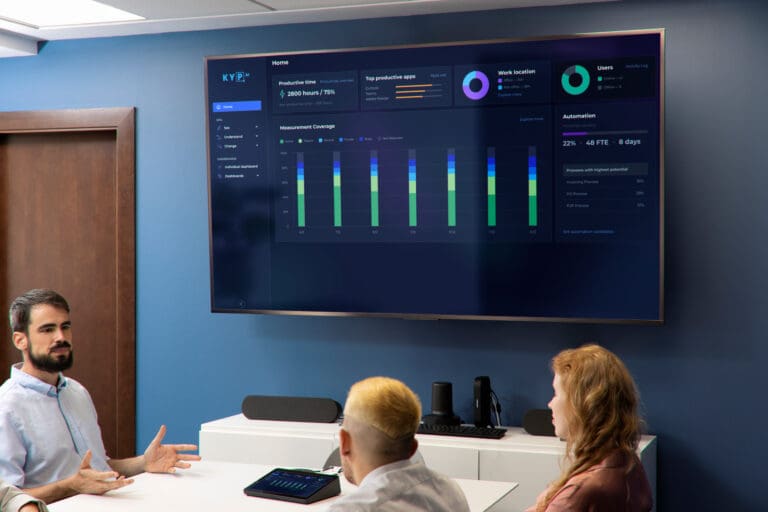What if you could recover 20-30% of your annual revenue by simply understanding how work flows through your organization?
For Hollard Insurance, automated process analysis uncovered 307 hours of waste every month, just in their ticketing triage process. Within weeks, they had a roadmap to boost productivity by 20%. For Alorica, a leading BPO, the insights revealed $2.5 million in annual savings hiding in plain sight. These process analysis case studies highlight how modern businesses can uncover the reality of work using technology, prescriptive insights and a smart use of artificial intelligence.
In this article we summarize everything you need to know to level up process analysis in today’s digitalized workplace.
What does process analysis mean in today’s digitalized business operations?
Process analysis is the systematic examination of how work flows through an organization to identify inefficiencies, bottlenecks, and improvement opportunities. It answers fundamental questions: How do tasks move from start to finish? Where do delays occur? Which steps add value versus waste time?
Organizations conduct process analysis for three primary reasons. First, to reduce operational costs by eliminating redundant activities and streamlining workflows. Second, to improve service quality by identifying error-prone steps and standardizing best practices. Third, to enable automation by understanding which processes are stable enough to hand off to technology.
Effective process analysis reveals both the as-is and should-be state of work across the enterprise
For many businesses, process analysis is all about understanding how work gets done. It is used to map the “as-is” state of core processes to uncover inefficiencies.
The business value of process analysis extends beyond cost savings. Effective process analysis reveals hidden capacity within existing teams, accelerates time-to-market for products and services, and improves employee satisfaction by removing frustrating manual work. For enterprise leaders, it provides data-driven justification for transformation investments rather than relying on intuition.
Increasingly, AI-driven process analysis solutions like KYP.ai are used to uncover the should-be state of processes capable of leveraging advanced technology such as agentic AI.
Key steps in conducting effective process analysis
Successful process analysis follows a structured approach, though execution varies based on methodology.
- Define scope and objectives. Start by identifying which processes to analyze and what business outcomes matter most. Is the goal cost reduction, quality improvement, or automation readiness? Clear objectives prevent analysis paralysis and ensure findings drive action.
- Capture current state reality. Document how work actually happens, not how policies claim it should happen. This means observing real workflows, collecting data from systems, and identifying variations across teams. The gap between documented procedures and actual execution often reveals the biggest improvement opportunities.
- Identify inefficiencies and root causes. Look for bottlenecks where work piles up, handoffs that cause delays, redundant activities that add no value, and error-prone steps requiring rework. Understanding why these issues exist – inadequate training, poor system design, unclear ownership – guides effective solutions.
- Quantify impact and prioritize. Not all inefficiencies deserve immediate attention. Calculate the time, cost, or quality impact of each issue. Prioritize improvements based on ROI potential and implementation feasibility. This prevents scattered efforts that yield minimal business value.
- Design and validate improvements. Create future-state processes that eliminate identified waste. Test proposed changes with stakeholders before full implementation. Validate that improvements work in practice, not just in theory.
- Measure and sustain results. Track KPIs to confirm improvements deliver expected benefits. Establish ongoing monitoring to catch process drift before efficiency gains erode. Continuous measurement ensures transformation sticks.
The challenge? Traditional process analysis approaches execute these steps too slowly for today’s pace of change. Manual process discovery or mapping can take months. By the time recommendations reach decision-makers, business conditions have shifted. This lag explains why many consultant-led process improvement initiatives fail to deliver promised ROI.
Common process analysis methods and their limitations
Organizations employ various approaches to understand their processes, each with distinct strengths and critical gaps.
| Method | What it captures | Strengths | Critical limitations |
| Traditional manual methods (flowcharting, value stream mapping, interviews) | High-level workflows based on employee recollection and documentation | Engaging teams in improvement efforts; documenting intended processes | Subjective, slow, doesn’t scale; captures only what people remember or share; misses variations across teams and geographies; months to map single departments |
| Process mining | Event logs from ERP, CRM, and enterprise systems | Reveals actual system transaction sequences; exposes bottlenecks in structured workflows (order-to-cash, procure-to-pay) | Only sees what systems record; misses human activities between transactions (emails, calls, spreadsheets, decision-making); requires months of implementation and expensive data integration; incomplete view of knowledge-intensive processes |
| Task mining | Desktop activities through screen recording and activity monitoring | Shows how employees actually work with applications; captures manual steps between system transactions | Privacy concerns may limit adoption; shows what people do without always explaining why it matters |
The fundamental gap: None of these traditional approaches provide what modern enterprises need: comprehensive visibility into how people, processes, and technology interact across the organization, combined with ROI-driven prioritization and the ability to rapidly enable automation at scale. In the end of this article you’ll find how the gap can be bridged.
Common challenges to business process analysis
The modern enterprise is a complex web of interconnected processes, each generating terabytes of data. Traditional analysis methods and business process management suites simply cannot keep up. They’re slow, siloed, and often outdated before implementation begins.
But the real obstacles run deeper than outdated BPM methods and tools. Here are some of the most common challenges we observe in enterprise businesses, global business services (GBS) and shared service centers.
Cultural resistance derails even the best analysis. Your organization may have cutting-edge process analysis capabilities, but if stakeholders don’t buy in, nothing changes. We’ve seen countless initiatives stall because management wasn’t committed or teams feared the implications of transparency. Communication gaps between departments lead to misunderstood requirements and competing priorities that pit finance against operations, IT against business units.
Requirements keep shifting under your feet. Stakeholders start with vague needs that evolve mid-analysis. Scope creep adds features without proper assessment, blowing budgets and timelines. You’re analyzing processes that changed three times since you started. Meanwhile, tight deadlines and limited resources force teams to compromise quality—delivering surface-level insights that miss the real problems.
Process complexity overwhelms traditional approaches. Your workflows span multiple systems, involve countless dependencies, and vary significantly across teams and geographies. Documenting these intricate processes manually is nearly impossible. Different teams use different tools, creating scattered documentation that nobody can find when they need it. Goals misalign across stakeholders, causing constant priority shifts. And just when you think you have it mapped, external regulations change, impacting multiple systems simultaneously
The ultimate challenge? Transforming that overwhelming deluge of data into laser-focused insights you can actually use, while navigating cultural resistance, shifting requirements, and process complexity that traditional analysis methods simply can’t handle.
Process analysis in the age of agentic AI
The emergence of agentic AI, that is autonomous agents that can execute complex workflows with minimal human intervention, fundamentally changes what process analysis can deliver.
According to McKinsey’s 2025 State of AI research, 62 percent of organizations are already experimenting with AI agents, and 23 percent have begun scaling agentic AI systems somewhere in their enterprises. Yet the research reveals a critical gap: while interest in AI agents is high, most organizations remain in pilot phases, struggling to transition from experimentation to scaled impact. One key reason? Limited process visibility and understanding cannot deliver what agentic AI requires to succeed.
Traditional process analysis aimed to understand and document workflows for human improvement. Map the current state, identify inefficiencies, recommend changes, hope humans implement them correctly. This approach assumed humans would remain the primary executors of work.
Agentic AI flips this model. Autonomous agents can execute processes faster and more consistently than humans. Their key limitation: for AI agents to work they need to receive the right instructions and context. This creates three new requirements that traditional process analysis methods cannot meet:
- Structured business context for AI agents. Agentic AI requires rich, company-specific understanding of how work flows through your organization. Not just what happens, but why certain steps exist, how they connect to business objectives, what exceptions occur, and how to handle them.
- ROI-driven prioritization of automation opportunities. Process analysis must now distinguish between what can be automated and what should be automated. Many processes are technically automatable but deliver minimal business value. Others offer substantial ROI but require prerequisite improvements. Without ROI-driven prioritization grounded in actual process data, organizations waste resources automating the wrong workflows.
- Production-ready agent code and execution instructions. Identifying automation opportunities isn’t enough. Enterprises need clear objectives, detailed action data, and executable code that AI agents can run immediately. Traditional process analysis delivers PowerPoint decks and recommendations.
This is where agentic process intelligence emerges as a new category, combining comprehensive operational visibility with ROI prioritization and AI enablement to help enterprises successfully deploy autonomous agents at scale.
KYP.ai: your agentic process intelligence partner
KYP.ai pioneers agentic process intelligence as the only platform purpose-built to enable enterprises to harness the full potential of agentic AI for process automation and transformation.
The platform addresses every limitation we’ve discussed through three integrated pillars:
360° View on the Organization captures and correlates data across people, processes, and technology to provide a unified, fact-based view of how work actually gets done. This includes end-to-end task-level process execution, workforce behavior, and system usage—exposing inefficiencies and bottlenecks that traditional methods miss. Unlike process mining’s system-centric view or task mining’s privacy-challenged approach, KYP.ai provides comprehensive context without the blind spots.
Business Transformation Engine converts raw data into actionable intelligence by quantifying inefficiencies and calculating automation ROI. It prioritizes high-impact automation opportunities aligned with business goals, empowering decision-makers with precise diagnostics. This solves the critical challenge of distinguishing what CAN be automated from what SHOULD be automated.
Agentic AI Enabler generates structured business context, action details, and ready-to-use AI agent code, supplying autonomous AI agents with the instructions and environment they need to reliably execute complex workflows at scale. This works beyond just browser automation—extending to Windows, MacOS, legacy systems, and enterprise applications.
Together, these pillars turn fragmented process data into a powerful foundation for AI agents to autonomously transform work, optimize operations, and deliver measurable business value with unprecedented speed and accuracy.
The bottom line: from process analysis to agentic process transformation
Process analysis has reached an inflection point. Traditional analysis methods – such as process manual mapping, process mining, task mining – provide partial visibility but cannot deliver what modern enterprises need: comprehensive understanding of how people, processes, and technology interact, combined with ROI-driven prioritization and the ability to rapidly enable automation at scale.
The stakes are clear. Inefficient processes silently drain 20-30% of annual revenue. For a $100 million organization, that’s $20-30 million lost every year. Meanwhile, the emergence of agentic AI creates both urgency and opportunity. Enterprises that successfully deploy autonomous agents will dramatically outpace competitors still relying on manual work and fragile RPA bots.
Success requires moving beyond traditional process analysis to agentic process intelligence. Through this platform shift you unlock the convergence of comprehensive operational visibility, ROI-focused prioritization, and AI enablement that transforms process insights into autonomous action.
Ready to uncover the hidden opportunities in your business operations? Explore how KYP.ai can transform your process analysis.
Discover Your Productivity Potential – Book a Demo Today
Book Demo








